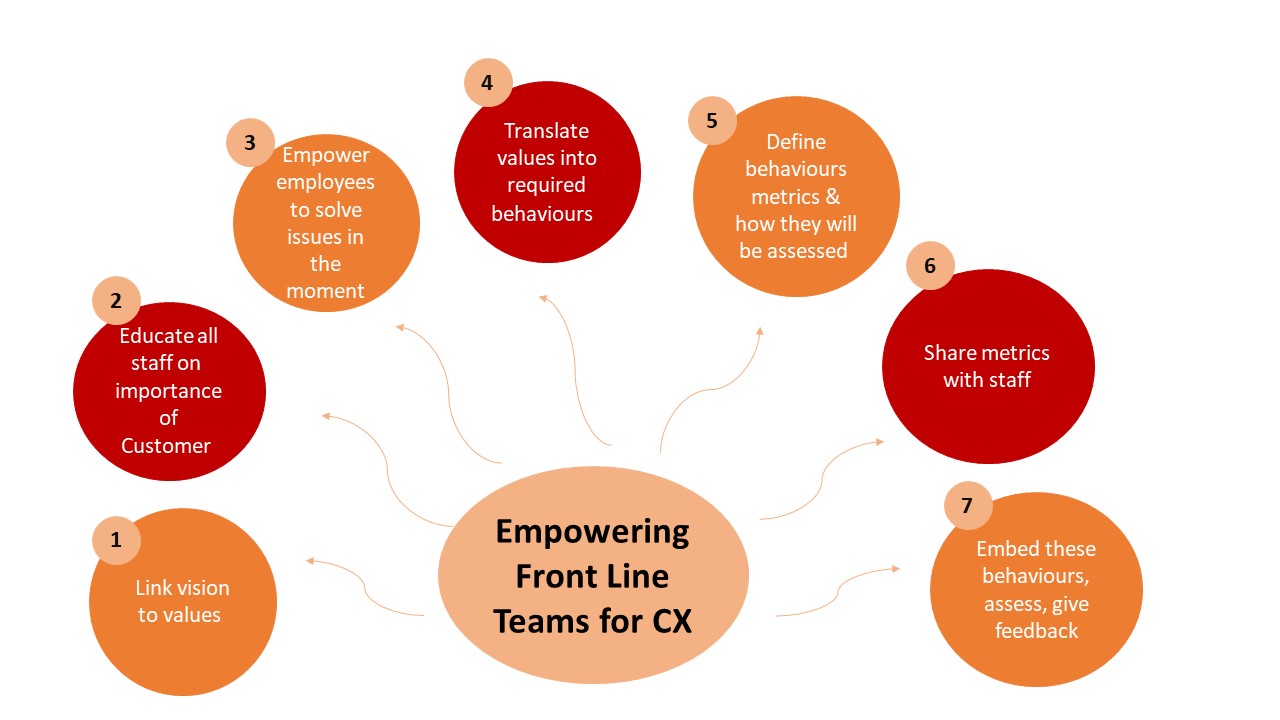How to Translate Customer Experience Strategy into Actionable Behaviours
Jo Brennan, shares her insights on how customer expectations are at an all-time high.

Technology is driving the desire for needs & expectations to be met at every interaction. So, when a customer gets in touch with a human being, they are expecting service to be excellent as they take time out of their day to contact you. The price for failing to deliver on their expectations has never been higher as customers take to social media to slate you for your systems or employees lack of knowledge, lack of skill, inadequate or too long responses.
The ability to deliver these customer experiences depends on the extent to which ‘customer- centricity’ is embedded within every single person in your business. This must be part of the culture driven by the leadership team.
According to Deloitte there are 7 areas to consider when embedding the customer at the heart of your organisation…
- Lead from the top with a customer focused approach - senior management need to own it
- Understand your customers - use customer profile data to gain deep understanding of your customer groups
- Design the experience - It is crucial to understand what the customer’s journey looks like across the product lifecycle
- Empower the frontline - remove the need to escalate decision making to allow issues to be resolved promptly
- Engage the supporting operations - support functions such as Procurement, IT, HR & Finance also need to adopt a customer-centric approach in carrying out their duties
- Encourage the right behaviours - Motivated & empowered employees will go that extra mile to ensure that customers are satisfied, particularly during the key ‘moments of truth’ in the customer relationship.
- Use customer feedback to drive real-time improvements - define a customer insight & feedback strategy that allows managers to identify & prioritise customer feedback from social media channels within hours. This will allow operational changes in near real-time.
In this article we focus on the challenges of Empowering the frontline & Encouraging the right behaviours supporting service recovery in the moment.
The vision & strategy for Customer Experience is set by the leadership team & with customer centricity at the heart of their decisions, the customer has a seat at the board table. It is up to operational teams to translate this strategy into day to day actions, behaviours or everyday processes of dealing with the customer.
For Operations teams to succeed this strategy needs to be embedded into the culture of the organisation & become their way of being. As one Customer Service Director put it – ‘this is the way we do things around here’. In researching this topic, I asked various types of organisations across different industries & geographies - how they manage & implement their customer strategy. The approach that comes back with having the most success is that of including all teams in defining this strategy translation & putting in place a standard framework & guidelines that employees can work from. These guidelines need to be very specific & very usable in day-to-day activities for all employees.

- Link vision to values - Run workshops with representatives from all departments to define values for customer facing employees that are in line with the overall vision. These should include what each value means in day-to-day use.
- Educate - all internal teams on the importance of the customer & the role of customer facing staff. Non-customer facing staff need to understand how they should work with them to help resolve issues for the customer promptly. Every one of these staff should understand they are there to support someone who is facing the customer.
- Empower your teams - trust the team to make the right decision for the customer. Give them a level of freedom that can boost their creativity within a defined process e.g. Ritz Carlton allow employees a budget to manage any issue if it is within budget. These processes will need to be agreed up front by operational teams to enable service recovery in the moment. Customers do not want to hear ‘I need to check that with my Supervisor’.
- Translate values into behaviours - Once values have been defined for customer-facing teams the next step is to translate these values into everyday behaviours. These should be very explicit & should become the standards by which all employees represent themselves to their internal & external customers. For customer facing staff these values & behaviours need to be broken down into everyday language for your brand, for every situation such as – dealing with a difficult customer, a complaint, a return etc.
- Set metrics to assess whether these standards are being met (these should be developed in conjunction with your team, creating buy-in). Once you have defined a clear set of standards then you can measure using NPS, Customer Satisfaction rates, Quality Scorecards etc. Assess your front-line staff interactions with customers e.g. if a behaviour standard is to always say, ‘Thank you for doing business with us’ then you need to understand how you are going to measure whether that language is being used.
- Share these metrics with the rest of the organisation to help them understand how you make your customers feel. Also share how these will be assessed, so everybody understands what they are working towards. By keeping employees informed & involved in the process you will keep them engaged & empowered to do their very best for your customer.
- Embed these behaviours, values in employees – this needs to be an ongoing process as changing existing behaviours can be challenging & will take time. Employees who naturally have the key skills to engage a customer need to understand what are the key messages, behaviours you want demonstrated for your brand to your customers consistently. A process of education & embedding of new behaviours through workshops, follow-on exercises & reminders with ongoing feedback should be put in place. Where there are large disparate numbers of employees, a structured automated process that measures & assesses should be considered to ensure engagement & consistency.
Remember a successful customer experience programme runs hand in hand with a good employee engagement & enablement process. Technology is changing the standards of customer engagement as customers embrace new digital service channels. In order to stay competitive in the Fourth Industrial Revolution your customer experience strategy is what will differentiate you.
To find out how Jamjou can help you embed behaviours around your customer experience, please visit our webpage jamjou.com.
Credit:
 Jo Brennan is CEO of Jamjou, an Interactive Skills & Behaviours Coaching App that accelerates the embedding of knowledge, service & sales standards using the latest technologies and agile techniques.
Jo Brennan is CEO of Jamjou, an Interactive Skills & Behaviours Coaching App that accelerates the embedding of knowledge, service & sales standards using the latest technologies and agile techniques.